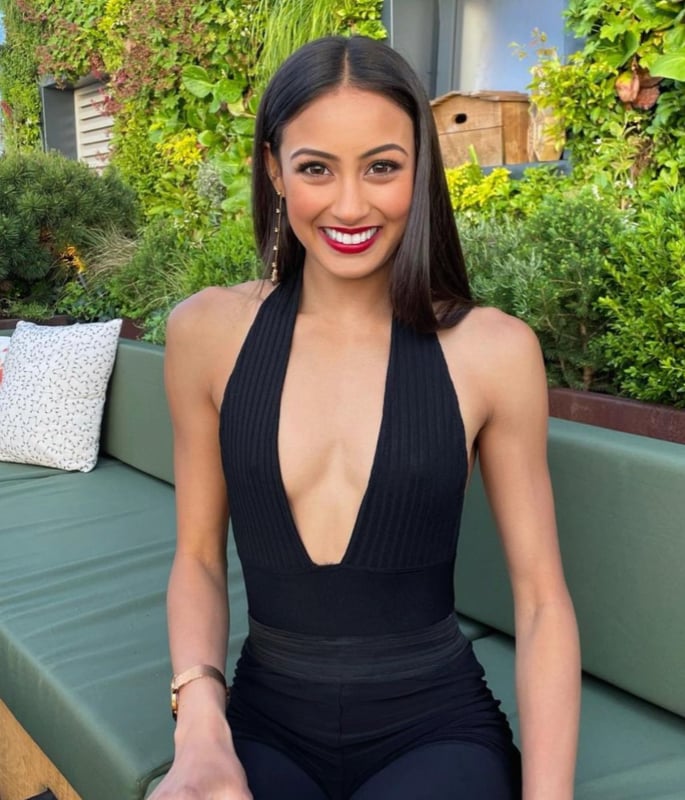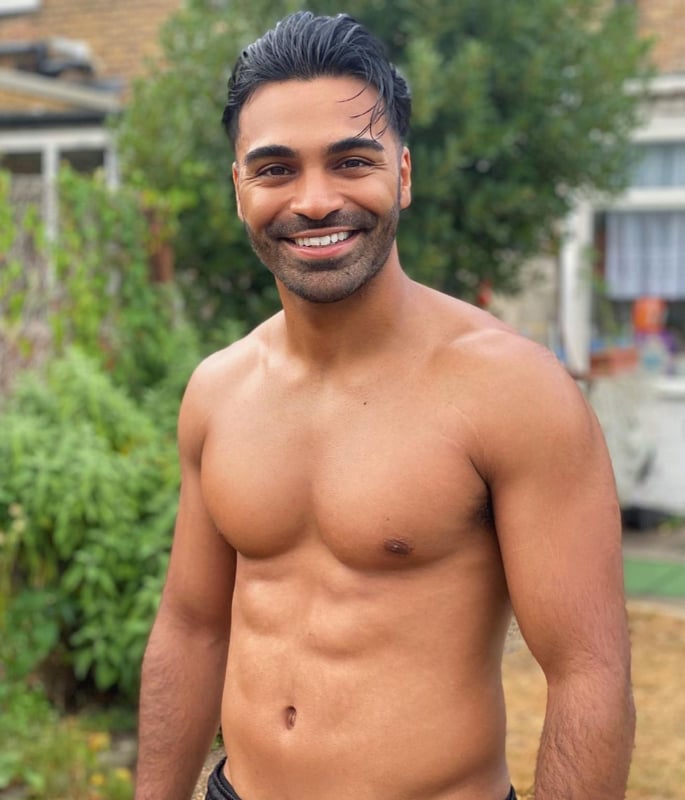Why is Desi Representation on Dating Shows Limited?
South Asians rarely get the airtime they deserve.
Dating shows have historically been dominated by western spaces, however, pockets of South Asian representation are now opening up, but is it enough?
With an increased focus on equal representation across the television industry, it appears dating shows are still falling behind.
Dating shows across the UK, US and Australia, either have little or no representation of South Asians at all and often miss the mark on accurately portraying individuals.
DESIblitz looks at South Asian representation across different dating shows and how they may appear limited.
South Asian Representation
 The reality TV industry is very much a white-dominated space with TV screens predominantly featuring white individuals or only individuals who fit Eurocentric beauty standards.
The reality TV industry is very much a white-dominated space with TV screens predominantly featuring white individuals or only individuals who fit Eurocentric beauty standards.
The lack of authentic South Asian representation in reality TV, especially dating shows, is nothing new and has been a point of criticism and debate regarding several shows.
The hit ITV reality dating show, Love Island has been one show in particular that has come under fire for its lack of diversity, inaccurate representation and tokenism of people of colour.
Despite its criticism, Love Island is one of the few dating shows that has featured South Asian representation albeit only a little.
In the entirety of its 9 seasons, Love Island has cast only cast 7 South Asian contestants with the latest being Sanam Harrinanan who has already turned heads in the villa.
However, many of these South Asians rarely get the airtime they deserve or they are clouded by preconceptions and stereotypes.
For example, Shannon Singh who appeared on Love Island season 7, only lasted two days in the love island villa.
Following Shannon’s exit, season 7 was shaping up to be a great season for South Asian representation with Priya Gopaldas later entering the villa.
However, Priya’s entrance into the villa indicated that representation had its limits, with her entrance garnering mixed reviews from audiences.
Many audiences did not like Priya and were taken aback by her love for Boris Johnson and even took to comparing her to the conservative British politician, Priti Patel.
21-year-old Love Island viewer, Tia Gopal, said:
“As much as I love South Asian representation in reality shows, this was not the representation I wanted to see or claim at all.”
Despite the limited representation in Love Island, it remains one of the few dating shows that feature more than one South Asian presence as many still do not.
Take the hit Netflix show, Too Hot To Handle for example which despite its 4 seasons, is yet to feature anyone of South Asian descent.
Other hit dating shows like Love is Blind, Dated and Related, The Bachelor, and Temptation Island all feature little or limited South Asian cast members.
In the rare cases like Love Island where South Asians are featured, they are clouded in stereotypes, given little airtime and rarely make it to the final of these shows.
Does this Representation have its Limits?
 As previously mentioned, South Asian representation on dating shows has its limits, especially when it comes to accurate representation.
As previously mentioned, South Asian representation on dating shows has its limits, especially when it comes to accurate representation.
However, the premise of many of these dating shows involves actively applying for them and then getting picked to be on the show.
This begs the question of whether the limits of South Asian representation lie in a lack of applicants applying to these shows or in the individuals selecting people to go on them.
If South Asians are simply not picked by producers to go on these shows, then how are they ever going to make it onto the screen?
However, when the representation is there, it hasn’t necessarily been favoured or appreciated by South Asian audiences.
As previously mentioned, the arrival of Priya Gopaldas stirred controversy amongst South Asian audiences when she entered the villa.
Due to her Tory background and political views, many South Asian audiences felt that was not the representation of South Asians that they wanted to see.
However, individuals also began attacking Priya with racist comments following her stint on the show which caused her friends to defend her and condemn those who were trolling her.
Despite the trolling she received online, Priya has since spoken up about her experiences of going on Love Island since leaving and has called out the lack of diversity in the reality TV industry in general.
In response to the qualms about the representation she offers and the backlash she faces, she said:
“I think we need more diversity on reality TV shows, especially Asian representation, more women of different sizes and more women who aren’t cosmetically enhanced.”
Priya’s sentiment has also been shared by other reality stars like Lauren Speed who was upset by the lack of black women in Love is Blind, the show she featured in its first series.
Lauren tweeted to her followers: “I don’t like how LIB be cutting all the black women.
“How come they are always in the trailer but not the show…”
For individuals who agree with Lauren’s sentiment, the lack of representation in dating shows may be a core reason why individuals will be less inclined to even watch the shows themselves.
Despite being a newer show Netflix’s Too Hot To Handle is also a dating show that features little to no South Asian representation.
24-year-old Too Hot To Handle fan, Shreya Rai, said:
“As a Too Hot To Handle fan and a South Asian, I’m not too bothered by the lack of representation in the show since I watch it for the entertainment and drama, not to see myself in the contestants.”
Whilst representation is there it is constantly in limited formats and though some viewers may find that to be an issue, others don’t place too much emphasis on needing representation when watching these shows.
Thus the lack of representation does not massively impact dating shows as individuals will watch them regardless of representation as they have been doing for decades with many mainstream television shows.
30-year-old reality television fan, Deena Lad said:
“I think reality dating shows like Love is Blind and Love Island have been doing a great job in recent years with casting a diverse set of contestants and I think improved diversity in dating shows is what will keep viewers hooked.”
Whilst the diversity might not hit the nail on the head right now, it appears some viewers have hope that dating shows will be set to diversify their future contestant pools, especially if they want to ensure the longevity and modernity of shows.
Lack of Male South Asian Representation
 Whilst there appears to be an overall slight increase in South Asian representation on dating shows there still appears to be a gap when it comes to male South Asian representation.
Whilst there appears to be an overall slight increase in South Asian representation on dating shows there still appears to be a gap when it comes to male South Asian representation.
Many male South Asians tend to get even less time on air than other contestants and are even more overlooked.
On Love Island, there have only been three male South Asian contestants, Nas Majeed, Omar Sultani, and Niall Aslam.
However, all three contestants were constantly faced with trolling, racist comments, and exoticization during their time in the villa.
Love Island’s Twitter even participated in the exoticisation towards Nas Majeed who perhaps gained the most airtime out of the three contestants.
A tweet by the Love Island Twitter account compared him to the Disney character Aladdin, which may not seem derogatory at first but is a highly problematic comment to make about a brown man.
The comparison fails to acknowledge that Nas is Pakistani and Caribbean.
Therefore, there is an obvious failure to distinguish between South Asian and Arab cultures and in this instance treats individuals as a homogenous cluster of brown society.
There was even a comment by his Love Island partner at the time, Siannise Fudge that he looked like Aladdin and the nickname had then stuck throughout the season which received 36 Ofcom complaints at the time.
The representation of South Asian males is therefore clouded in exoticisation in the same way it is for South Asian females.
They are not only exoticized but also heavily restricted to inaccurate and unforgiving representations that can cause people to make sweeping generalisations about the whole South Asian male population.
For instance, Love is Blind contestant Shake Chatterjee who appeared in season 2, gave an arguably bad name to South Asian men and even became the villain of the series.
Shake made misogynist comments throughout his appearance on Love is Blind, constantly asking intrusive questions to women about their appearance and weight.
However, Shake’s misogynist and disrespectful attitudes do not accurately represent the views of all South Asian men.
His actions should not serve as a means to generalise all South Asian men as misogynists.
From the current portrayals of South Asian contestants on dating shows, it’s clear that producers and casting directors have a long way to go before south Asians are truly and accurately represented.
As it stands the space for representation remains very limited and restricted by the confines of Eurocentric beauty standards, unconscious bias and colourist attitudes which means fewer South Asians are getting to appear on television.
Stigma towards dating shows also still exists within the South Asian community which may prevent individuals from even putting themselves forward for such shows.
Therefore, attitudes towards who gets to appear on dating shows on both sides need improvement before they can be considered truly inclusive to remove limitations that are placed on South Asians.